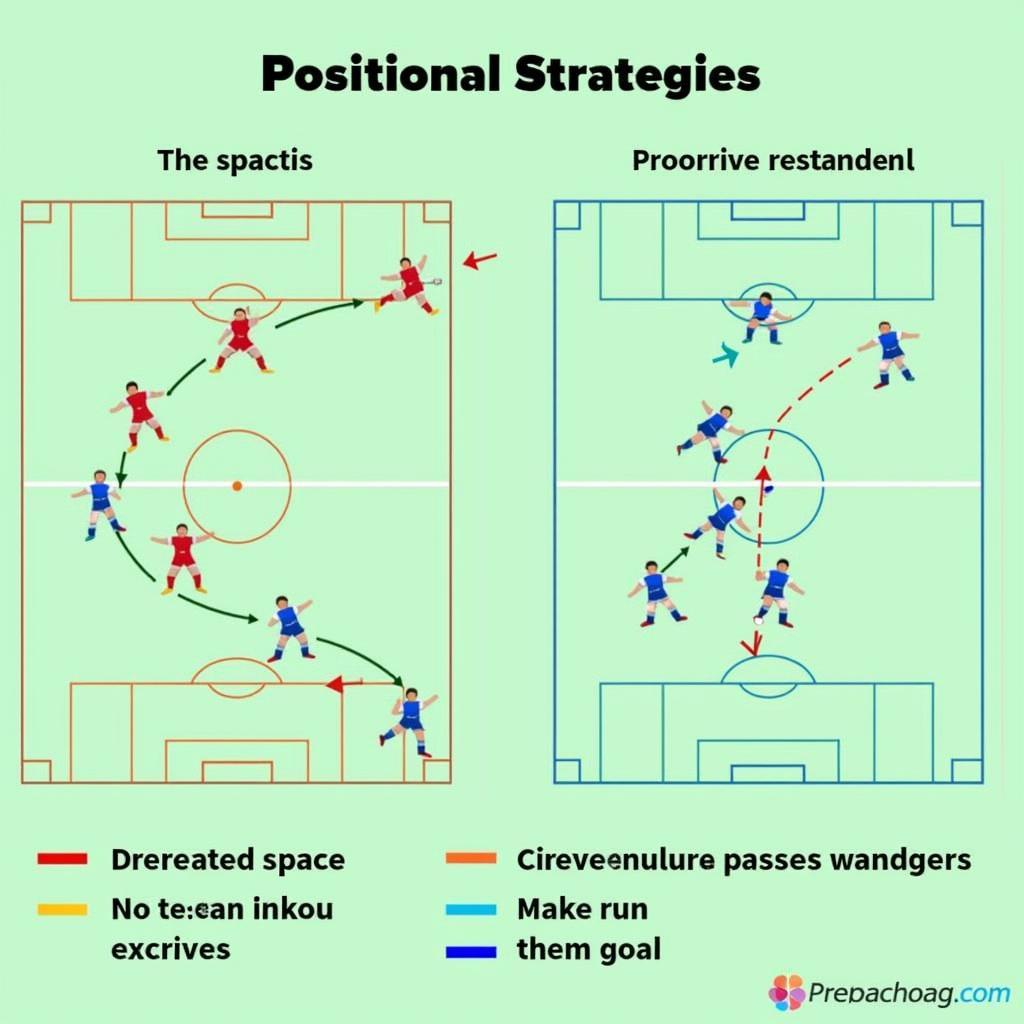Understanding Football Player Positions: A Comprehensive Guide
October 29, 2024Football is a complex game, and understanding the roles and responsibilities of each player position is crucial for both players and fans. This guide will delve into the specifics of each position, exploring their tactical significance and how they contribute to a team’s overall success.
The Importance of Player Positioning in Football
Effective player positioning is the cornerstone of a successful football team. It dictates the flow of the game, influences attacking and defensive strategies, and ultimately determines the outcome of matches. Whether it’s a striker lurking in the box or a midfielder controlling the tempo, every position has a unique and vital role to play.
Offensive Player Positions
Offensive players are responsible for creating scoring opportunities and putting the ball in the back of the net. Their positioning is critical for exploiting weaknesses in the opponent’s defense and maximizing attacking potential.
Strikers
Strikers, or forwards, are the primary goal scorers. They operate closest to the opponent’s goal, utilizing their speed, agility, and finishing skills to capitalize on chances. A striker’s positioning needs to be intelligent, anticipating passes and making runs that create space for themselves or their teammates.
Wingers
Wingers play on the flanks of the pitch, providing width to the attack. They use their pace and dribbling skills to take on defenders, delivering crosses into the box or cutting inside to create scoring opportunities. Their positioning is key for stretching the opponent’s defense and creating space in central areas.
Attacking Midfielders
Attacking midfielders play behind the strikers, linking the midfield and attack. They possess excellent vision and passing abilities, creating chances for the forwards while also contributing goals themselves. Their positioning is crucial for dictating the tempo of the attack and exploiting gaps in the opponent’s midfield.
 Attacking Midfielder Positioning Strategies: Examples of how attacking midfielders position themselves to create scoring opportunities and link midfield with attack.
Attacking Midfielder Positioning Strategies: Examples of how attacking midfielders position themselves to create scoring opportunities and link midfield with attack.
Defensive Player Positions
Defensive players are responsible for preventing the opposition from scoring. Their positioning is critical for maintaining a solid defensive structure and neutralizing the opponent’s attack.
Defenders
Defenders, or center-backs, form the heart of the defense. Their primary role is to prevent the opposition from scoring, using their strength, tackling abilities, and aerial prowess to intercept passes and clear the ball. Positioning is crucial for defenders, ensuring they maintain a compact defensive line and prevent gaps from appearing.
Full-backs
Full-backs play on the flanks of the defense, providing defensive cover while also supporting the attack when needed. They need to be versatile, capable of defending against wingers and overlapping to provide width in attack. Their positioning is key for maintaining defensive solidity while contributing to the team’s attacking build-up.
Defensive Midfielders
Defensive midfielders shield the defense, breaking up opposition attacks and winning back possession. They possess excellent tackling and interception skills, disrupting the opponent’s flow and providing a link between defense and midfield. Their positioning is crucial for maintaining defensive stability and initiating counter-attacks.
Midfield Player Positions
Midfielders connect the defense and attack, playing a crucial role in both phases of the game. Their positioning is essential for controlling the tempo, distributing the ball, and creating attacking opportunities.
Central Midfielders
Central midfielders are the engine room of the team. They dictate the tempo of the game, controlling possession and distributing the ball to the attacking players. Their positioning is key for maintaining a balance between attack and defense, linking the two halves of the team seamlessly.
Wide Midfielders
Wide midfielders operate on the flanks, providing width in midfield. They contribute to both attack and defense, supporting the wingers in attack while tracking back to help the full-backs in defense. Their positioning is crucial for maintaining width and providing a link between midfield and attack.
Conclusion
Understanding the nuances of football player positions is fundamental to appreciating the tactical complexities of the beautiful game. Each position contributes uniquely to a team’s success, and effective positioning is the key to unlocking their full potential. From the striker’s clinical finishing to the defender’s resolute defending, every player’s position plays a vital role in the overall strategy and outcome of a match.
FAQ
- What is the most important position in football? Every position is important, contributing to the team’s success in different ways.
- How does a player’s position affect their training? Training is tailored to the specific demands of each position, focusing on relevant skills and physical attributes.
- Can players change positions during a game? Yes, players can switch positions tactically, depending on the flow of the game and the manager’s instructions.
- What are the key attributes of a good striker? Speed, agility, finishing, and positional awareness are essential for a striker.
- How does positioning contribute to a team’s defensive strategy? Organized and disciplined positioning is crucial for maintaining a solid defensive structure and preventing the opposition from scoring.
- What is the role of a captain in relation to player positioning? The captain often organizes and directs player positioning on the field, ensuring the team maintains its shape and tactical discipline.
- How does the formation of a team affect player positioning? The formation dictates the starting positions of players and their general areas of operation on the field.
Need more assistance? Contact us: Phone: 0396443476, Email: [email protected] or visit us at 23 Tháng 3, Đắk Nia, Gia Nghĩa, Đắk Nông, Việt Nam. We have a 24/7 customer service team.